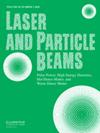基于混合注入辅助激光尾流场加速器的紧凑型汤姆逊散射源
IF 1.9
4区 物理与天体物理
Q4 PHYSICS, APPLIED
引用次数: 0
摘要
为了建立紧凑的全光汤姆逊散射源,在45tw钛蓝宝石激光设备上进行了实验研究。通过将钢晶片、混合气体和等离子体反射镜整合到双出口射流中,将冲击辅助电离注入、电离注入和驱动激光反射等多种机制集成到一个源中。因此,复杂性的来源大大减少了。可以产生中心能量在90 - 160 MeV之间波动的电子束。等离子体反射镜用于反射驱动激光。反射的激光在电子束上的散射导致了x射线光子的产生。通过比较不同实验条件下的x射线光斑,证实了x射线光子是由汤姆逊散射产生的。为了进一步应用,测量了汤姆逊散射源的能谱和源尺寸。展开后的光谱除了在67 keV附近有一个峰外,还含有大量的低能光子。通过将电子能谱输入到蒙特卡罗模拟代码中,利用发射角大小的光子的不同贡献来解释展开谱的起源。最大光子能量扩展到500 keV左右。总光子产量为107个/脉冲。FWHM源尺寸约为12 μm。本文章由计算机程序翻译,如有差异,请以英文原文为准。
Compact Thomson Scattering Source Based on a Mixed Injection Assisted Laser Wakefield Accelerator
In order to establish a compact all-optical Thomson scattering source, experimental studies were conducted on the 45 TW Ti: sapphire laser facility. By including a steel wafer, mixed gas, and plasma mirror into a double-exit jet, several mechanisms, such as shock-assisted ionization injection, ionization injection, and driving laser reflection, were integrated into one source. So, the source of complexity was remarkably reduced. Electron bunches with central energy fluctuating from 90 to 160 MeV can be produced. Plasma mirrors were used to reflect the driving laser. The scattering of the reflected laser on the electron bunches led to the generation of X-ray photons. Through comparing the X-ray spots under different experimental conditions, it is confirmed that the X-ray photons are generated by Thomson scattering. For further application, the energy spectra and source size of the Thomson scattering source were measured. The unfolded spectrum contains a large amount of low-energy photons besides a peak near 67 keV. Through importing the electron energy spectrum into the Monte Carlo simulation code, the different contributions of the photons with small and large emitting angles can be used to explain the origin of the unfolded spectrum. The maximum photon energy extended to about 500 keV. The total photon production was 107/pulse. The FWHM source size was about 12 μm.
求助全文
通过发布文献求助,成功后即可免费获取论文全文。
去求助
来源期刊

Laser and Particle Beams
PHYSICS, APPLIED-
CiteScore
1.90
自引率
11.10%
发文量
25
审稿时长
1 months
期刊介绍:
Laser and Particle Beams is an international journal which deals with basic physics issues of intense laser and particle beams, and the interaction of these beams with matter. Research on pulse power technology associated with beam generation is also of strong interest. Subjects covered include the physics of high energy densities; non-LTE phenomena; hot dense matter and related atomic, plasma and hydrodynamic physics and astrophysics; intense sources of coherent radiation; high current particle accelerators; beam-wave interaction; and pulsed power technology.
 求助内容:
求助内容: 应助结果提醒方式:
应助结果提醒方式:


